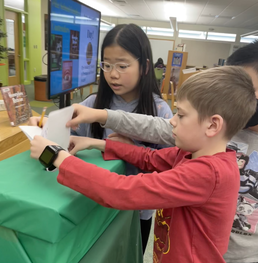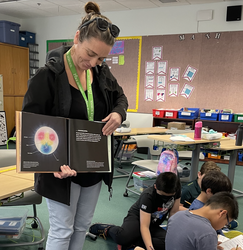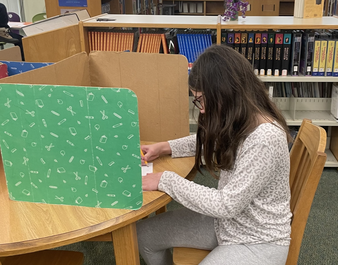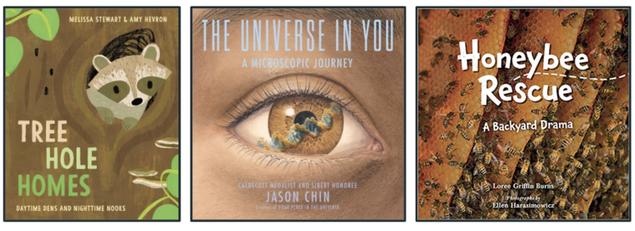
During the course of this year, I’ve been excited to re-connect with teachers to support curriculum, especially because a new built-in meeting structure with teaching teams has created consistent co-planning time.
When I floated the idea of piloting a Mock Sibert Award election with students this year, the 4th grade teachers were all in! They saw how it would deepen learning, and were very willing to commit classroom time to make this experience meaningful for the students.
Which Books to Choose?
Given the realities of the school schedule and the vagaries of New England winter weather, we could only examine three titles, in order that the mock voting would align as closely to the real Sibert announcement as possible. I chose illustrated texts that could be read aloud in one class period. Books also needed to be relevant and engaging to a range of 4th grade readers. I decided that students would have more success when comparing titles with a similar focus. My final choices all were science/nature oriented, but offered contrast in terms of narrative style and visual presentation.
I knew I needed to mirror the text feature and craft move language that LA teachers focus on in their teaching. I also wanted to write the criteria as questions, since this framework would make it easier for students to tap into their thinking. After reading the Sibert Medal criteria closely and reviewing other Mock Sibert materials, I decided on three areas, with a total of five questions. Melody Allen’s student-friendly version of the Sibert criteria, as described on Melissa Stewart’s blog, was a valuable tool in this process. Here’s the result:
Pike Mock Sibert Criteria (adapted from the Sibert criteria) When deciding if a book is distinguished, the 4th grade Mock Sibert Committee will use these guiding questions:
CRAFT
- Does the author use excellent and engaging language?
- Is the visual presentation excellent and engaging?
- Are the ideas and facts organized, presented clearly, and documented with a bibliography?
- Do the text features (table of contents, index, maps, photos, timelines, etc.) enhance understanding of the facts and ideas?
- How highly does the book interest me?

Our collaborative plan began in December with me introducing the exciting Mock Sibert process to students in our weekly library time, and teachers launching the Language Arts non-fiction unit in classrooms. Students learned about the actual award at the same time that they also visited the library with their LA classes for non-fiction book tastings. I read Antoinette Portis’ Hey, Water! aloud to introduce students to the skill of evaluating a book with our “Three Cs” criteria in mind. In the LA classrooms, instruction focused on identifying non-fiction text features and observing the choices writers and illustrators make to engage the reader.

In January, we dove into reading our three contenders. Students heard each book twice; the second time, they wrote their observations and thoughts on a recording sheet. Each teacher found time in their schedule for me to do this second reading and recording session, and it was invaluable for students to see us co-teaching. We also held brief discussions where students shared their observations, appreciations, and questions about choices the authors and illustrators made.

In preparation for our Mock Sibert election, students reviewed the books and their recording sheets. After making a decision about their top choice, they wrote a paragraph explaining their reasoning. I also previewed what the ballot would look like, explaining that students would assign a rank to every contender.
Students wrote thoughtfully about their choice. “Organized and full of facts” was one student’s content-based reason for voting for Tree Hole Homes. Writing about The Universe in You, students cited the excellent craft moves of “everything getting smaller,” and the use of a repeating refrain with a “dot-dot-dot” right before each page turn. Students especially appreciated the use of photographs in Honeybee Rescue, and wrote about their strong connection to the narrative-style presentation. “I feel like I’m rooting for the bees.”
On the afternoon of January 30, teachers escorted their classes to the library, where I checked students in at the door (very official!) and gave them a ballot. You could have heard a pin drop as they went to their “voting booth” and picked up the provided pencil.
Armed with a large coffee and my trusty tabulation sheet, I got to work unfolding the huge pile of ballots. As tally marks mounted, one front runner emerged, only to have a different book take its place. When all the votes were counted, three votes separated the top two books and…three students had been absent. I was scheduled to announce the winner to the entire grade the next morning! The teachers and I decided that if the students were not in school the next day, we’d cast their votes by proxy, using the information from the paragraphs they had written.
Those three votes made a huge difference. The outcome was - a tie. By the voting criteria of the real Sibert committee, we did not have a clear winner. For the students, though, the message that every vote mattered was powerful, and the announcement was met with cheers and applause.
Burns, Loree Griffin. Honeybee Rescue: A Backyard Drama. Illustrated by Ellen Harasimowicz, Charlesbridge, 2022.
Chin, Jason. The Universe in You: A Microscopic Journey. Holiday House, 2022.
Portis, Antoinette. Hey, Water! Neal Porter Books, 2019.
“Robert F. Sibert Informational Book Medal.” American Library Association. Association for Library Service to Children, a division of the American Library Association, 2015, https://www.ala.org/alsc/awardsgrants/bookmedia/sibert. Accessed 30 January 2023.
Stewart, Melissa. “5 Kinds of Nonfiction.” Melissa Stewart: Science Books and Nonfiction Teaching Resources, Melissa Stewart, 2023, https://www.melissa-stewart.com/books/teachers/bk_5_kinds_nonfiction.html. Accessed 5 January 2023.
Stewart, Melissa. “It’s Time for the Sibert Smackdown!” Celebrate Nonfiction: Exploring the Joy of Nonfiction Reading and Writing, Melissa Stewart, 17 November 2022, https://celebratescience.blogspot.com/2022/11/its-time-for-sibert-smackdown.html. Accessed 22 November 2022.
Stewart, Melissa. Tree Hole Homes: Daytime Dens and Nighttime Nooks. Illustrated by Amy Hevron, Random House, 2022.



